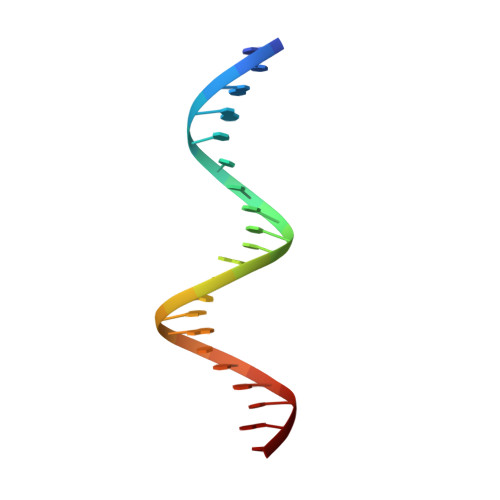Identification of intrinsic dynamics in a DNA sequence preferentially cleaved by topoisomerase II enzyme
Masliah, G., Rene, B., Zargarian, L., Fermandjian, S., Mauffret, O.(2008) J Mol Biol 381: 692-706
- PubMed: 18585388
- DOI: https://doi.org/10.1016/j.jmb.2008.06.024
- Primary Citation of Related Structures:
2JYK - PubMed Abstract:
Topoisomerase II enzymes are essential enzymes that modulate DNA topology and play a role in chromatin compaction. While these enzymes appear to recognize and cleave the DNA in a nonrandom fashion, factors that underlie enzyme specificity remain an enigma. To gain new insights on these topics, we undertake, using NMR and molecular dynamics methods, studies of the structural and dynamic features of a 21 bp DNA segment preferentially cleaved by topoisomerases II. The large size of the oligonucleotide did not hamper the determination of structures of sufficient quality, and numerous interesting correlations between helicoidal parameters already depicted in crystals and molecular dynamics simulations are recovered here. The main feature of the sequence is the occurrence of a large opening of the base pairs in a four-residue AT-rich region located immediately at the 5' end of one of the cleaved sites. This opening seems to be largely dependent on sequence context, since a similar opening is not found in the other AT base pairs of the sequence. Furthermore, two adenine nucleotides of the same portion of the oligonucleotide present slow internal motions at the NMR timescale, revealing particular base dynamics. In conclusion, this AT-rich region presents the most salient character in the sequence and could be involved in the preferential cleavage by topoisomerase II. The examination of preferred sites in the literature pointed out the frequent occurrence of AT-rich sequences, namely matrix attachment region and scaffold attachment region sequences, at the sites cleaved by topoisomerase II. We could infer that the particular flexibility of these sequences plays an important role in enabling the formation of a competent cleavage complex. The sequences could then be selected based on their facility to undertake conformational change during the complex formation, rather than purely based on binding affinity.
Organizational Affiliation:
LBPA, Centre National de la Recherche Scientifique (UMR8113), Ecole Normale Supérieure de Cachan, F-94235 Cachan, France.















